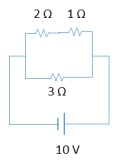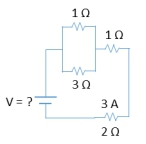Hey, guys. So in this video, we're going to talk about how to solve more complicated circuit problems. Let's check it out. Alright. So in some circuit problems, you'll be asked to find not just the equivalent resistance but also the current I and the voltage V of different resistors. Alright, so let's see how we do that. But first, let me remind you that resistors can be connected in series or in parallel. And if they're in series, this is the equation you use to find the equivalent resistance. This is the equation for equivalent resistance in parallel. Remember that in parallel there are also 2 shortcut equations you can use, 2 shortcuts. So this is old news. What's new here is this stuff here. Right? And when you have resistors in series, they will share current with each other. They will share current with each other. So for example, if I have a 1 ohm resistor, 2 ohms, and 3 ohms, and if I know that this current here is 2 amps, then I know if I'm given the current here is 2 amps, then I know that this here has to be 2 amps. And then I know that this here also has to be 2 amps because they're in a series. The current's flowing this way. It has nowhere to go, so it has to just flow with a constant 2 amps. So they share currents with each other. Cool. Now you need to remember that but you also have to remember that they share current with the equivalent resistor as well. So they share current with the equivalent resistor. What does that mean? Well, if I combine these, I just add them. So I have 1, 2, and 3. This is a 6 ohm resistor. But this 2 here is not only the same for these guys, but it's also the same here. So I'm going to know that this has to be a 2-amp current going through this resistor. So not only is the current the same with each other when you're combining in series but also with the combined merged resistor. K? Very important. One way to think about this is that these guys combine to form the equivalent resistor, and the equivalent resistor will inherit the current because it's coming from a series combination. In parallel, it's not current, it's the voltage that will be the same. K? So the voltage will be the same with each other and also with the equivalent resistor. So let's say this is a 9 ohm resistor, 9 ohm resistor, 9 ohm resistor. You may remember from the shortcut that if I have 3, 9 ohms, the equivalent resistance would just be 9 ohms divided by 3 because there are 3 of them. So the equivalent resistance is 3. That's old news. But let's say I know that this is let's say I know that this is 5 volts. Well, if this guy is 5 volts, it must follow that this guy right here is also 5 volts and this guy here is also 5 volts. Because if they are in parallel, which they are, they have to share the same voltage with each other. And not only with each other but also with the merged equivalent resistor. So the voltage here would also be 5 volts. You can think that when you combine them in parallel, the equivalent resistor will inherit the voltage. K? These points are super important for you to remember. Please do not forget. Now that's important for you to solve the problems. Now here are the 3 steps that you're going to use in solving all of these problems. We're going to be very systematic about this, very systematic. Cool? The first one is you're going to get, you're going to get some sort of weird resistor network here like this and you're going to collapse, 1 equivalent resistor. And we're going to do this using the techniques we already talked about.
So this is old news. Okay? This is old, you know how to do this. Then you're going to find voltage and currents on the equivalent resistor. Once you get down to 1 resistor, you're going to be able to find the voltage and the current on it. And by the way, you're going to do this using Ohm's law, \( v = IR \), which combines currents and voltage with resistance. K? This is old because we've seen \( v = IR \) and it's also really easy. It's a very quick step. Now the hard part is step 3 where we are going to work backwards noting voltage and current on each resistor. Now don't worry about what that means yet. I'm going to show you and the best way to show you is just by doing an example. K? So let's walk through this simple example here and we're going to use these steps to find the current and voltage across each one of these resistors. K? So let's draw small here because we're going to need a lot of space. So the first thing we're going to do, remember from the rules up there, is that we're going to get everything down to 1 resistor. And you know how to do this. The first place I'm going to start is by combining these 2 in parallel. K? I'm going to combine these 2 in parallel. So I'm going to draw the circuit here in black and then circuit here in black. I'm going to leave some space there. This is the 6 ohm resistor and this is the 10 volt battery right here. And this is the combination of the combination of the 2 with the 1. I'm going to do one of these and I'm going to write here that this is a parallel merge. K?



